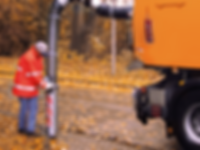Microbe-resistant and hydrolysis-resistant suction hoses and transport hoses
Their resistance to microbes and hydrolysis makes them perfect hoses for the waste disposal and cleaning industry
Microbes feel particularly at home in outdoor and green waste applications, for example when mowing grass or transporting leaves. Especially when materials become heavily contaminated in contact with earth-like substrates during operation. A combination of moisture, high temperatures and biological processes particularly stresses hoses. This typically often comes into play in municipal waste disposal and cleaning vehicles.
Microbe-resistant hoses from Masterflex have been optimized for these applications through the materials used and their special manufacturing. They are flexible and robust - especially with regard to abrasion resistance and resistance (to rotting and moisture).
MaterialsConstruction & Manufacturing
Depending on the planned application and the expected requirement profile, we offer lightweight or heavier microbe- and hydrolysis-resistant hoses with a wide range of diameters. Our safety and quality requirements and our experienced staff enable you to find exactly what you are looking for.
Materials for hydrolysis-resistant and microbe-resistant hoses
Our hydrolysis-resistant and microbe-resistant hoses are made of polyester and ether polyurethane. This type of hose with a milky hose wall helps in applications where clogging inside the hose is easy - for example, when sucking up manure residues. For applications in which microbe-resistant and/or hydrolysis-resistant hoses are used, they are usually subjected to strong and dynamic movements, as is the case, for example, in street cleaning sweeping and suction vehicles. Here, the polyurethane material used scores with its good mechanical properties under tensile and compressive loads as well as deformation.
The ether polyurethane used by Masterflex in production has the advantage that the material is already permanently resistant to microbes and hydrolysis without any further additives, and no extra microbicides have to be added. In outdoor applications, these properties of the ether variant of polyurethane come into their own particularly well.
Ether polyurethane, which is microbe-resistant due to its chemical structure, is the perfect material for hoses that come into contact with earth-like substances during operation and are subjected to stress and heavy soiling. These conditions - often combined with permanently humid and warm environments - take their toll on normal hoses in outdoor applications, causing them to weather and wear quickly. In polyester-based materials, the ester compounds are gradually broken down by the enzymes of microorganisms. However, the polyether polyurethane we use can also be a good alternative for many applications in this area.

Design and manufacturing process of hydrolysis resistant and microbe resistant hoses.
The hoses with microbe and hydrolysis resistance are mainly extruded hose models made of specially adapted materials. The production method results in outwardly folded hoses and a largely smooth surface in the inner bend. This results in optimized flow properties - relevant, for example, in the extraction of leaves and in street sweeping machines around various sweeping and disposal areas.
Most Masterflex microbe- and hydrolysis-resistant suction and transport hoses have a medium wall thickness with a high-performance property profile - they can withstand high loads and score high points for flexibility. Electrically dischargeable hoses are useful in the field of fiber and chip conveying, as in industrial vacuum cleaners, and are available from us. A particularly lightweight special model with microbe and hydrolysis resistance is our Master-PUR STEP MHR film hose. This is also tread-resistant - an interesting combination for installation in portable municipal equipment.
Standards for hydrolysis and microbe resistant hoses
Many hoses from this section meet specific standards and DIN regulations. Individual standards may comply with the following regulations:
- DIN 4102 B1
- DIN 26057
- DIN EN ISO 8031
- TRGS 727 and ATEX 2014/34 EU.
Inform here about TRGS conformity
We understand how to support you and your very specific requirements in the best possible way with our products. Please contact us for expert advice on the relevant standards and approvals for hydrolysis- and microbe-resistant hoses.
















